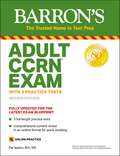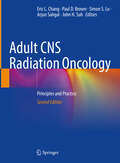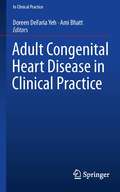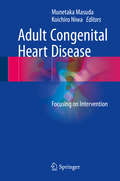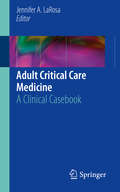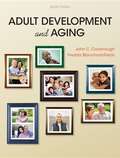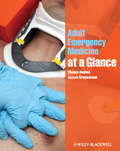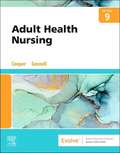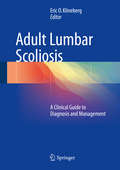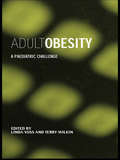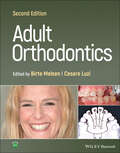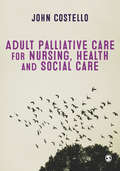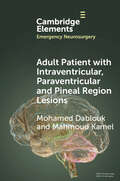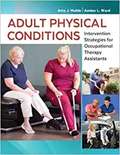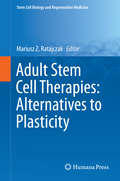- Table View
- List View
Adult CCRN Exam: With 3 Practice Tests (Barron's Test Prep)
by Patricia Juarez APN CCNSBarron&’s Adult CCRN Exam provides all of the key concepts you need to pass the Adult CCRN exam, with detailed review and full-length practice tests to help you feel prepared.This book features:A 25-question pretest to help pinpoint areas in need of intensive studyDetailed subject reviews, including Cardiovascular Concepts, Pulmonary Concepts, Professional Caring and Ethical Practice Concepts, and more, in an easy-to-digest outline format, along with corresponding practice questions and answer explanationsTwo full-length practice CCRN tests in the book, each with 150 multiple-choice questions and fully explained answersOne full-length online practice exam with all questions answered and explainedMore than 500 practice questions overall, for review and studyCCRNs who have successfully passed the test report that self-study with sets of practice questions is an excellent strategy for success. Don&’t take chances with your certification—let Barron&’s CCRN Exam help you achieve the next level of professional achievement.
Adult CNS Radiation Oncology: Principles And Practice
by Simon S. Lo Eric L. Chang Paul D. Brown Arjun Sahgal John H. SuhThis book elucidates the radiation therapy protocols and procedures for the management of adult patients presenting with primary benign and malignant central nervous system tumors. With the development of new treatment strategies and rapid advancement of radiation technology, it is crucial for radiation oncologists to maintain and refine their knowledge and skills. Dedicated exclusively to adult CNS radiation oncology, this textbook explores CNS tumors ranging from the common to the esoteric as well as secondary cancers of metastatic origin. The first half of the book is organized anatomically: tumors of the brain, spinal cord, leptomeninges, optic pathway, ocular choroid, and skull base. The second half covers primary CNS lymphoma, rare CNS tumors, metastatic brain disease, vascular conditions of the CNS, radiation-associated complications, and radiation modalities. Each chapter provides guidance on treatment field design, target delineation, and normal critical structure tolerance constraints in the context of the disease being treated. Learning objectives, case studies, and Maintenance of Certification Self-Assessment Continuing Medical Education-style questions and answers are incorporated throughout the book. This is an ideal guide for radiation oncologists, residents, and fellows, but medical students may also find value in the text.
Adult CNS Radiation Oncology: Principles and Practice
by Simon S. Lo Eric L. Chang Paul D. Brown Arjun Sahgal John H. SuhThis new edition elucidates the radiation therapy protocols and procedures for the management of adult patients presenting with primary benign and malignant central nervous system tumors. With the development of new treatment strategies and rapid advancement of radiation technology, it is crucial for radiation oncologists to maintain and refine their knowledge and skills. Dedicated exclusively to adult CNS radiation oncology, this textbook explores CNS tumors ranging from the common to the esoteric as well as secondary cancers of metastatic origin. The first half of the book is organized anatomically: tumors of the brain, spinal cord, leptomeninges, optic pathway, ocular choroid, and skull base. The second half covers primary CNS lymphoma, rare CNS tumors, metastatic brain disease, vascular conditions of the CNS, radiation-associated complications, and radiation modalities. This new edition is updated throughout and includes several new chapters, including: palliative radiation therapy for leptomeningeal disease, preoperative treatment for brain metastases, advanced neuroimaging for brain tumors, and MR-LINAC for brain tumors. Each chapter provides guidance on treatment field design, target delineation, and normal critical structure tolerance constraints in the context of the disease being treated. Learning objectives, case studies, and Maintenance of Certification Self-Assessment Continuing Medical Education-style questions and answers are incorporated throughout the book. This is an ideal guide for radiation oncologists, residents, and fellows, but medical students may also find value in the text.
Adult Congenital Heart Disease in Clinical Practice (In Clinical Practice)
by Doreen DeFaria Yeh Ami BhattThere is an evident practice gap in education of general adult cardiologists on long-term management of congenital heart disease (CHD). The goal of this book is to help general cardiologists, but also pediatricians and related care providers in the management and diagnosis of adult CHD.Adult Congenital Heart Disease in Clinical Practice provides clear, practical advice on adult CHD for the busy fellow, resident and practicing clinician. It includes training and revision material to assist learning and is formatted in such a way as to provide short, concise content designed for easy recall of salient facts.
Adult Congenital Heart Disease: Focusing on Intervention
by Koichiro Niwa Munetaka MasudaThis book describes the most popular topics concerning adult congenital heart disease (ACHD), especially focusing on indications and re-intervention procedures for some major ACHDs. Thanks to advances in medical and surgical therapy for congenital heart disease over the last half century, many patients who underwent surgical correction reached adulthood. However, as can be seen from the explosive increase in the number of ACHD patients, postoperative residua and sequelae have also become apparent. The purpose of this book is to highlight complicated problems in connection with ACHD, including its present status, as well as methods for its management including medical and surgical treatment. The content primarily focuses on two areas - general information for cardiologists, and information on re-intervention for interventionists and cardiac surgeons -, setting it apart from the majority of books on congenital heart disease.
Adult Craniopharyngiomas: Differences and Lessons from Paediatrics
by Emmanuel Jouanneau Gérald RaverotThis volume focuses on adult craniopharyngiomas, offering various perspectives. The first part of the book provides an up-to-date overview of the pathogenesis and management of adult craniopharyngiomas, helping readers understand the pathogenesis and molecular pathways. It highlights the importance of animal models for addressing molecular keys and for developing targeted therapies. The second part deals with clinical management, detailing the latest results in the era of endoscopic surgery, including the major contribution of the extended nasal endoscopic approaches for suprasellar and retrochiasmatic tumors. The book also discusses the key aspects of these tumors and how to manage them. The last part of the book addresses the future therapies and recurrences after surgery and radiotherapy. This volume is of interest to neurosurgeons, endocrinologists, paediatricians, radiologists and oncologists.
Adult Critical Care Medicine: A Clinical Casebook
by Jennifer A. LaRosaThis clinical casebook provides a comprehensive yet concise state-of-the-art review of adult critical care medicine. Presented in a case-based format, each case focuses on a scenario commonly encountered with an adult patient in the ICU. Case scenarios include management of seizures and acute intracranial hypertension, sepsis, liver failure, brain death, bleeding and thrombosis, and treating hospital acquired infections in the ICU. Written by experts in the field, Adult Critical Care Medicine: A Clinical Casebook is a valuable resource for critical care specialists and practitioners who treat adult patients in critical care settings.
Adult Day Care: A Practical Guidebook and Manual
by Lenore A Tate Cynthia M BrennanIntended for long-term care providers, consumers, and gerontology students, this valuable new guidebook and manual encourages the promotion and enhancement of adult day care as an essential link in long-term care. Since the early 1970s, the number of adult day care centers in the United States has grown from 20 to more than 620. This rapid increase in adult day care programs indicates that it is an important health care and social resource that has begun to fill a necessary gap in the long-term care system. To further meet the increasing needs, this new book provides information regarding the history, definition, and concept of adult day care; models of care; scope of activities; state and national policy; and samples of forms and reports needed for daily operations.
Adult Development and Aging
by John C. Cavanaugh Fredda Blanchard-FieldsWritten within a bio-psychosocial framework, Cavanaugh and Blanchard-Fields' best-selling text covers the specific ages-stages of adult development and aging. In its unparalleled coverage of current research and theory, the authors draw clear connections between research and application. The book's focus on ""positive aging"" and the gains and losses people experience across adulthood distinguish it from its competitors.
Adult Emergency Medicine at a Glance (At A Glance Ser. #46)
by Thomas HughesFollowing the familiar, easy-to-use at a Glance format, and in full-colour, this brand new title provides an accessible introduction and revision aid for medical students and junior doctors. Reflecting the increased profile of Emergency Medicine in clinical practice and the medical school curriculum, Adult Emergency Medicine at a Glance provides a user-friendly overview of the key subjects that will enable any student or junior doctor to 'hit the ground running' when they enter one of the most exciting areas of clinical medicine. Adult Emergency Medicine at a Glance is: A concise, visually orientated course in emergency medicine that is perfect for both study and revision Organised around symptoms: 'Short of Breath', rather than diagnoses: 'Pneumonia' Focused on the most common or dangerous conditions you will see in the Emergency Department and includes the latest cardiac resuscitation guidelines Comprehensively illustrated throughout with over 47 full-page colour illustrations
Adult Emergency Medicine: Self-Assessment Color Review
by John O'BrienThis new volume in the established and well-respected series of Self-Assessment Color Reviews covers all aspects of adult emergency medicine. Some 250 cases are presented randomly to reflect real-life practice. Each case consists of one or more questions, illustrated by stimulating visual material including clinical photographs, imaging and electro
Adult Epilepsy
by Gregory Cascino Joseph SirvenDesigned to provide a comprehensive but accessible introduction to epilepsy and seizure disorders, Adult Epilepsy provides state-of-the-art information in a concise format useful to a wide audience, from neurology residents to epilepsy fellows and practitioners. This illustrated guide to the assessment, diagnosis, and treatment of epilepsy is a valuable resource enabling clinicians to stay on top of the latest recommendations for best practice.
Adult Health Nursing
by Kim Cooper Kelly GosnellMaster the LPN/LVN’s role and responsibilities in medical-surgical nursing! With coverage organized by body systems, Adult Health Nursing, 9th Edition provides an essential guide to nursing care for patients with common disorders. Through use of the nursing process, you will develop clinical judgment skills to assess patient needs, develop nursing care plans, and plan effective nursing interventions. Case studies provide practice with critical thinking and clinical judgment, and new Next Generation NCLEX®-format questions help you apply theory to practice. Written by nursing educators Kim Cooper and Kelly Gosnell, this text also helps you prepare for success on the NCLEX-PN® examination. Step-by-step instructions for skills show clearly defined nursing actions along with the rationales for each. Overview of Anatomy and Physiology begins each body systems chapter, and the Introduction to Anatomy and Physiology chapter provides a clear, basic understanding of the A&P that LPN/LVNs need to know. The nursing process is applied to the discussion of disorders, and is summarized at the end of each chapter. Nursing care plans use a case-study format to emphasize patient goals and outcomes, and include critical thinking questions at the end of each care plan. Evidence-Based Practice boxes provide synopses of research articles that apply to nursing, along with nursing implications for the LPN/LVN. Safety Alert! boxes cover issues related to safe patient care in a variety of settings. Coordinated Care boxes promote comprehensive patient care with other members of the health care team, focusing on prioritization, assignment, supervision, collaboration, delegation, and leadership topics. Lifespan Considerations boxes provide age-specific information for the care of the patient. Older Adult Considerations boxes provide age-specific information for the care of the aging population, which is often the primary focus of the LPN/LVN nurse. Communication boxes illustrate communication strategies through real-life examples of nurse-patient dialogue. Patient Teaching boxes focus on three-way communication among the nurse, patient, and family members, and include topics such as hospital discharge instructions. Health Promotion Considerations boxes highlight information on wellness and disease prevention, including infection control, diet, and pregnancy. Home Health Considerations boxes discuss issues facing patients and their caregivers in the home setting. Medication tables provide quick access to action, dosage, precautions, and nursing considerations for commonly used drugs. Get Ready for the NCLEX® Examination sections provide key points, review questions, and critical thinking activities to reinforce learning. NEW! Next Generation NCLEX® case studies and new format questions help you prepare for success on the NCLEX-PN® examination. NEW! Discussion of the NCSBN Clinical Judgment Measurement Model helps you develop the skills needed to plan effective nursing interventions. NEW! Updated Immune Disorder and HIV/AIDS chapters highlight the newest medical and drug therapies. NEW! Updated photos and illustrations show nursing techniques, procedures, and patient care.
Adult Hydrocephalus
by Daniele RigamontiAdult hydrocephalus is an insidious yet treatable condition that develops slowly, with usual onset around 60 years of age. It is poorly recognized and many cases are not diagnosed until late in the course of disease, leading to poorer patient outcomes and a high financial cost to healthcare providers. The resulting neurological symptoms include gait/balance problems, loss of bladder control, and a cognitive decline leading to dementia, which is often mistaken for Alzheimer's disease. This book - the first published on this topic since 1993 - provides comprehensive guidelines to improve the speed and accuracy of diagnosis, and covers various neurosurgical techniques used to treat the disease, including the insertion of different types of shunts and endoscopic third ventriculostomy. This is essential reading for neurologists, neurosurgeons, family physicians, and radiologists who may well encounter adult patients with hydrocephalus more often than they realize.
Adult Interpersonal Violence: Illuminating the Dark Side of Occupations
by Christine Helfrich Rebecca TwinleyThis unique volume uses an occupational perspective to shine a light on how the impact of interpersonal violence (IPV) affects people in their daily tasks and activities.The book recognises how the legacy of trauma – whether it be from one or more events that were physically, verbally, emotionally, sexually, or psychologically harmful or threatening – can be seen in the occupational experiences of both victim/survivors and perpetrators. It fills a distinct gap in the literature and highlights a pervasive issue – one which occupational therapists must regularly contend with. Edited by a leading scholar from both the United States and United Kingdom and including chapters on IPV within intimate relationships, stalking, and sexual assault, the book takes the field of occupational therapy into a new direction, setting the research agenda as well as, through invaluable clinical guidance, informing professional practice.This book will be essential reading for students, scholars and practitioners across the field of occupational science and occupational therapy.
Adult Lumbar Scoliosis: A Clinical Guide to Diagnosis and Management
by Eric O. KlinebergProviding a sound definition and review of the pertinent treatment goals for the management of adult lumbar scoliosis, this practical and comprehensive guide covers everything from pre-operative evaluation and radiography to post-operative management and complications. Both non-operative and operative strategies are presented, including minimally invasive techniques, decompression, anterior release, spinal osteotomy, and proximal and distal fixation, with an emphasis on clinical guidelines and management outcomes. The impact and prevention of complications following treatment are also discussed, including the prevention of proximal junctional kyphosis. Concluding with an examination of future directions for research and clinical treatment strategies, the comprehensive approach of this book provides the orthopedic surgeon, neurosurgeon and spinal practitioner with the most current evidence and expert thought about the evaluation and management of adult lumbar scoliosis.
Adult Malnutrition: Diagnosis and Treatment
by Jennifer MarianMalnutrition is a global health problem and results in significant clinical and financial consequences for people, communities, and healthcare institutions. Causes of malnutrition are often complex and multifactorial, and can include acute illness or injury, chronic disease, and a variety of socioeconomic factors. While many professional articles have been published on malnutrition, there is no single source of information that encompasses all aspects of the condition. Adult Malnutrition: Diagnosis and Treatment reviews the risk factors and etiologies of malnutrition, as well as screening, assessment, diagnosis, and treatment to aid healthcare professionals in the identification and successful care of individuals with this condition in a variety of settings. Features Discusses how to identify malnutrition risks through the use of validated nutrition screening tools in diverse settings Provides detailed instructions on conducting a nutrition-focused physical exam, including illustrations depicting differing degrees of muscle wasting and fat loss Presents information on risk factors, diagnosis, and treatment of vitamin and mineral deficiencies, including photos illustrating signs of deficiency to aid in diagnosis Details treatments for malnutrition related to acute illness/injury, chronic illness, social/environmental circumstances, or starvation Reviews challenges and potential solutions to malnutrition identification and treatment in healthcare institutions Edited by Jennifer Doley, MBA, RDN, CNSC, FAND, and Mary Marian, DCN, RDN, CSO, FAND, FASPEN, this book serves as a key text for registered dietitian nutritionists, health practitioners, and clinicians.
Adult Nursing: Preparing for Practice
by Dave Barton Andreé le MayA complete resource for your career in nursing; this book gives you a sound knowledge basis for effective care and best practice in hospital and community settings and, alongside this, explores the many routes your professional development can take.Part one explores the key aspects of the journey from commencing your adult nursing studies to becoming a consultant practitioner, researcher, manager or teacher, with the focus always on developing the best possible care.Part two looks at the five major care themes: first contact, access and urgent care; supporting long term and palliative care; acute and critical hospital care; mental health and psychosocial care; and public health and primary care. A holistic and practical approach draws together research, policy guidelines, and nurse and patient experiences.A companion website provides annotated weblinks to useful resources, PowerPoint presentations, interactive MCQs, and an 'ask the authors' feature. Presents the best evidence for practice Reflects UK policy directions and global health trends Text features include clinical case studies, patient perspectives, key points, colour illustrations and activities to aid learning Highlights career pathways and key areas for continuing professional development
Adult Obesity: A Paediatric Challenge
by Linda D. Voss Terence J. WilkinWhile it is increasingly clear that adult obesity begins in childhood, preventing this condition is a major challenge for the pediatrician.Adult Obesity: A Paediatric Challenge highlights the causes and consequences of obesity, bringing a modern understanding to the treatment of a heavily stigmatized problem. This collection of essays, base
Adult Orthodontics
by Birte Melsen Cesare LuziAdult Orthodontics Complete reference work covering the increasingly prominent area of adult orthodontics Written by renowned contributors from the orthodontic community and compiled by world-class editors, Adult Orthodontics, 2nd Edition is an authoritative resource on the subject of adult orthodontics, marrying together clinical guidance with a thorough evaluation of the evidence base. Sample topics discussed within the book include: Context for adult orthodontics, including patient demographics and aetiology Treatment planning considerations, including patient case profiles, initial outcomes and longer-term expectations Interdisciplinary and multidisciplinary approaches, including the links between adult orthodontics and periodontics, prosthetics, and temporomandibular disorders This book is an invaluable resource for professionals providing orthodontic treatment to adults and those dealing with orthodontics as part of the interdisciplinary management of the adult dentition.
Adult Palliative care for Nursing, Health and Social Care
by John CostelloIn this far-ranging textbook on palliative and end of life care, John Costello and a team of palliative care specialists take a patient-centred approach. Discussing palliative and end of life care across a range of diseases and illnesses, each chapter includes real-life case studies that focus on both the patient experience and the experiences of the family members of service users. Original in its approach to palliative and end of life care, Adult Palliative Care focuses on a range of non-cancer conditions. Thoughtfully balancing theory with practice, and interprofessional in its scope, Adult Palliative Care would benefit any health professional dealing with or working in the field of palliative and end of life care.
Adult Palliative care for Nursing, Health and Social Care
by John CostelloIn this far-ranging textbook on palliative and end of life care, John Costello and a team of palliative care specialists take a patient-centred approach. Discussing palliative and end of life care across a range of diseases and illnesses, each chapter includes real-life case studies that focus on both the patient experience and the experiences of the family members of service users. Original in its approach to palliative and end of life care, Adult Palliative Care focuses on a range of non-cancer conditions. Thoughtfully balancing theory with practice, and interprofessional in its scope, Adult Palliative Care would benefit any health professional dealing with or working in the field of palliative and end of life care.
Adult Patient with Intraventricular, Paraventricular and Pineal Region Lesions (Elements in Emergency Neurosurgery)
by Mohamed Dablouk Mahmoud KamelIntraventricular lesions are uncommon, and they can arise from numerous structures around the ventricular system, including the ependyma, septum pellucidum and choroid plexus. Pineal region lesions may arise from the pineal gland parenchymal/supporting cells or glial cells of the midbrain/medial thalamus. Many of these lesions are either found incidentally or present with symptoms of hydrocephalus. Careful assessment of the clinical and radiological features of each case can help to narrow the differential diagnosis in this heterogenous group of tumours.
Adult Physical Conditions: Intervention Strategies For Occupational Therapy Assistants
by Amy Mahle Amber WardThe go-to text/reference for class, clinical, and practice! A who’s who of experts and educators brings you practical, in-depth coverage of the most common adult conditions and the corresponding evidence-based occupational therapy interventions. Written for OTAs to meet their unique needs, this approach combines theory with the practical, evidence-based functional content that develops the critical-thinking and clinical-reasoning skills that are the foundation for professional, knowledgeable, creative, and competent practice.
Adult Stem Cell Therapies: Alternatives To Plasticity (Stem Cell Biology and Regenerative Medicine #40)
by Mariusz Z. RatajczakThis timely volume explores various techniques for tissue and organ regeneration using stem cells isolated from adult tissues. It discusses alternative explanations of stem cell plasticity as well as current clinical results with adult stem cell therapies. It examines the presence of potential pluripotent stem cells in adult tissues, paracrine effects of stem cell therapies, and involvement of exosomes and microparticles into observed phenomena. Fifteen chapters, all written by noted leaders of their fields, focus on a variety of topics including cord blood and hematopoietic stem cells, skin and tissue organ regeneration, very small embryonic-like stem cells, and cell therapies in cardiology, neonatology, and neurology. Edited by Dr. Mariusz Ratajczak, an internationally known specialist in adult stem cell biology, Adult Stem Cell Therapies: Alternatives to Plasticity is an important addition to the Stem Cell Biology and Regenerative Medicine series.
